+ データを開く
データを開く
- 基本情報
基本情報
| 登録情報 | データベース: PDB / ID: 6omm | |||||||||
|---|---|---|---|---|---|---|---|---|---|---|
| タイトル | Cryo-EM structure of formyl peptide receptor 2/lipoxin A4 receptor in complex with Gi | |||||||||
 要素 要素 |
| |||||||||
 キーワード キーワード | SIGNALING PROTEIN / Formyl peptide receptor 2/lipoxin A4 receptor / GPCR / Gi protein | |||||||||
| 機能・相同性 |  機能・相同性情報 機能・相同性情報N-formyl peptide receptor activity / complement receptor activity / immune response-regulating cell surface receptor signaling pathway / scavenger receptor binding / complement receptor mediated signaling pathway / positive regulation of innate immune response / Formyl peptide receptors bind formyl peptides and many other ligands / positive regulation of monocyte chemotaxis / cargo receptor activity / positive chemotaxis ...N-formyl peptide receptor activity / complement receptor activity / immune response-regulating cell surface receptor signaling pathway / scavenger receptor binding / complement receptor mediated signaling pathway / positive regulation of innate immune response / Formyl peptide receptors bind formyl peptides and many other ligands / positive regulation of monocyte chemotaxis / cargo receptor activity / positive chemotaxis / tertiary granule membrane / ficolin-1-rich granule membrane / Adenylate cyclase inhibitory pathway / positive regulation of protein localization to cell cortex / regulation of cAMP-mediated signaling / D2 dopamine receptor binding / G protein-coupled serotonin receptor binding / specific granule membrane / positive regulation of phagocytosis / regulation of mitotic spindle organization / cellular response to forskolin / adenylate cyclase-inhibiting G protein-coupled receptor signaling pathway / receptor-mediated endocytosis / positive regulation of superoxide anion generation / Regulation of insulin secretion / G protein-coupled receptor binding / G protein-coupled receptor activity / astrocyte activation / calcium-mediated signaling / microglial cell activation / G-protein beta/gamma-subunit complex binding / Olfactory Signaling Pathway / Activation of the phototransduction cascade / adenylate cyclase-modulating G protein-coupled receptor signaling pathway / G beta:gamma signalling through PLC beta / Presynaptic function of Kainate receptors / Thromboxane signalling through TP receptor / G-protein activation / G protein-coupled acetylcholine receptor signaling pathway / Activation of G protein gated Potassium channels / Inhibition of voltage gated Ca2+ channels via Gbeta/gamma subunits / Prostacyclin signalling through prostacyclin receptor / Glucagon signaling in metabolic regulation / G beta:gamma signalling through CDC42 / ADP signalling through P2Y purinoceptor 12 / G beta:gamma signalling through BTK / Synthesis, secretion, and inactivation of Glucagon-like Peptide-1 (GLP-1) / Sensory perception of sweet, bitter, and umami (glutamate) taste / response to peptide hormone / photoreceptor disc membrane / Adrenaline,noradrenaline inhibits insulin secretion / Glucagon-type ligand receptors / negative regulation of inflammatory response / Vasopressin regulates renal water homeostasis via Aquaporins / G alpha (z) signalling events / cellular response to catecholamine stimulus / Glucagon-like Peptide-1 (GLP1) regulates insulin secretion / ADORA2B mediated anti-inflammatory cytokines production / sensory perception of taste / ADP signalling through P2Y purinoceptor 1 / adenylate cyclase-activating dopamine receptor signaling pathway / G beta:gamma signalling through PI3Kgamma / cellular response to amyloid-beta / cellular response to prostaglandin E stimulus / Cooperation of PDCL (PhLP1) and TRiC/CCT in G-protein beta folding / GPER1 signaling / GDP binding / chemotaxis / G-protein beta-subunit binding / Inactivation, recovery and regulation of the phototransduction cascade / heterotrimeric G-protein complex / G alpha (12/13) signalling events / extracellular vesicle / signaling receptor complex adaptor activity / Thrombin signalling through proteinase activated receptors (PARs) / GTPase binding / retina development in camera-type eye / phospholipase C-activating G protein-coupled receptor signaling pathway / Ca2+ pathway / signaling receptor activity / amyloid-beta binding / cell cortex / midbody / G alpha (i) signalling events / positive regulation of cytosolic calcium ion concentration / fibroblast proliferation / G alpha (s) signalling events / G alpha (q) signalling events / cell population proliferation / Ras protein signal transduction / Extra-nuclear estrogen signaling / cell surface receptor signaling pathway / positive regulation of ERK1 and ERK2 cascade / cell adhesion / defense response to bacterium / inflammatory response / cell cycle / G protein-coupled receptor signaling pathway / cell division / lysosomal membrane 類似検索 - 分子機能 | |||||||||
| 生物種 |  Homo sapiens (ヒト) Homo sapiens (ヒト)synthetic construct (人工物) | |||||||||
| 手法 | 電子顕微鏡法 / 単粒子再構成法 / クライオ電子顕微鏡法 / 解像度: 3.17 Å | |||||||||
 データ登録者 データ登録者 | Zhuang, Y. / Liu, H. / de Waal, P.W. / Zhou, X.E. / Wang, L. / Meng, X. / Zhao, G. / Kang, Y. / Melcher, K. / Xu, H.E. / Zhang, C. | |||||||||
| 資金援助 |  米国, 2件 米国, 2件
| |||||||||
 引用 引用 |  ジャーナル: Nat Commun / 年: 2020 ジャーナル: Nat Commun / 年: 2020タイトル: Structure of formylpeptide receptor 2-G complex reveals insights into ligand recognition and signaling. 著者: Youwen Zhuang / Heng Liu / X Edward Zhou / Ravi Kumar Verma / Parker W de Waal / Wonjo Jang / Ting-Hai Xu / Lei Wang / Xing Meng / Gongpu Zhao / Yanyong Kang / Karsten Melcher / Hao Fan / ...著者: Youwen Zhuang / Heng Liu / X Edward Zhou / Ravi Kumar Verma / Parker W de Waal / Wonjo Jang / Ting-Hai Xu / Lei Wang / Xing Meng / Gongpu Zhao / Yanyong Kang / Karsten Melcher / Hao Fan / Nevin A Lambert / H Eric Xu / Cheng Zhang /    要旨: Formylpeptide receptors (FPRs) as G protein-coupled receptors (GPCRs) can recognize formylpeptides derived from pathogens or host cells to function in host defense and cell clearance. In addition, ...Formylpeptide receptors (FPRs) as G protein-coupled receptors (GPCRs) can recognize formylpeptides derived from pathogens or host cells to function in host defense and cell clearance. In addition, FPRs, especially FPR2, can also recognize other ligands with a large chemical diversity generated at different stages of inflammation to either promote or resolve inflammation in order to maintain a balanced inflammatory response. The mechanism underlying promiscuous ligand recognition and activation of FPRs is not clear. Here we report a cryo-EM structure of FPR2-G signaling complex with a peptide agonist. The structure reveals a widely open extracellular region with an amphiphilic environment for ligand binding. Together with computational docking and simulation, the structure suggests a molecular basis for the recognition of formylpeptides and a potential mechanism of receptor activation, and reveals conserved and divergent features in G coupling. Our results provide a basis for understanding the molecular mechanism of the functional promiscuity of FPRs. | |||||||||
| 履歴 |
|
- 構造の表示
構造の表示
| ムービー |
 ムービービューア ムービービューア |
|---|---|
| 構造ビューア | 分子:  Molmil Molmil Jmol/JSmol Jmol/JSmol |
- ダウンロードとリンク
ダウンロードとリンク
- ダウンロード
ダウンロード
| PDBx/mmCIF形式 |  6omm.cif.gz 6omm.cif.gz | 239.9 KB | 表示 |  PDBx/mmCIF形式 PDBx/mmCIF形式 |
|---|---|---|---|---|
| PDB形式 |  pdb6omm.ent.gz pdb6omm.ent.gz | 194.8 KB | 表示 |  PDB形式 PDB形式 |
| PDBx/mmJSON形式 |  6omm.json.gz 6omm.json.gz | ツリー表示 |  PDBx/mmJSON形式 PDBx/mmJSON形式 | |
| その他 |  その他のダウンロード その他のダウンロード |
-検証レポート
| 文書・要旨 |  6omm_validation.pdf.gz 6omm_validation.pdf.gz | 1.1 MB | 表示 |  wwPDB検証レポート wwPDB検証レポート |
|---|---|---|---|---|
| 文書・詳細版 |  6omm_full_validation.pdf.gz 6omm_full_validation.pdf.gz | 1.2 MB | 表示 | |
| XML形式データ |  6omm_validation.xml.gz 6omm_validation.xml.gz | 36.4 KB | 表示 | |
| CIF形式データ |  6omm_validation.cif.gz 6omm_validation.cif.gz | 55.5 KB | 表示 | |
| アーカイブディレクトリ |  https://data.pdbj.org/pub/pdb/validation_reports/om/6omm https://data.pdbj.org/pub/pdb/validation_reports/om/6omm ftp://data.pdbj.org/pub/pdb/validation_reports/om/6omm ftp://data.pdbj.org/pub/pdb/validation_reports/om/6omm | HTTPS FTP |
-関連構造データ
- リンク
リンク
- 集合体
集合体
| 登録構造単位 | 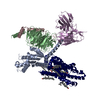
|
|---|---|
| 1 |
|
- 要素
要素
-Guanine nucleotide-binding protein ... , 3種, 3分子 ABC
| #3: タンパク質 | 分子量: 40327.891 Da / 分子数: 1 / Mutation: G203A, A326S, D328E / 由来タイプ: 組換発現 / 由来: (組換発現)  Homo sapiens (ヒト) / 遺伝子: GNAI1 Homo sapiens (ヒト) / 遺伝子: GNAI1発現宿主:  参照: UniProt: P63096 |
|---|---|
| #4: タンパク質 | 分子量: 39021.648 Da / 分子数: 1 / Mutation: Q6E, E130Q, N237D / 由来タイプ: 組換発現 / 由来: (組換発現)  Homo sapiens (ヒト) / 遺伝子: GNB1 Homo sapiens (ヒト) / 遺伝子: GNB1発現宿主:  参照: UniProt: P62873 |
| #5: タンパク質 | 分子量: 7430.584 Da / 分子数: 1 / Mutation: E17Q, E58Q / 由来タイプ: 組換発現 / 由来: (組換発現)  Homo sapiens (ヒト) / 遺伝子: GNG2 Homo sapiens (ヒト) / 遺伝子: GNG2発現宿主:  参照: UniProt: P59768 |
-タンパク質 / タンパク質・ペプチド / 抗体 , 3種, 3分子 RLE
| #1: タンパク質 | 分子量: 40329.238 Da / 分子数: 1 / 由来タイプ: 組換発現 / 由来: (組換発現)  Homo sapiens (ヒト) / 遺伝子: FPR2, FPRH1, FPRL1, LXA4R Homo sapiens (ヒト) / 遺伝子: FPR2, FPRH1, FPRL1, LXA4R発現宿主:  参照: UniProt: P25090 |
|---|---|
| #2: タンパク質・ペプチド | 分子量: 857.117 Da / 分子数: 1 / 由来タイプ: 合成 / 由来: (合成) synthetic construct (人工物) |
| #6: 抗体 | 分子量: 26323.324 Da / 分子数: 1 / 由来タイプ: 組換発現 / 由来: (組換発現) synthetic construct (人工物) / 発現宿主:  |
-非ポリマー , 2種, 8分子 


| #7: 化合物 | ChemComp-CLR / #8: 化合物 | |
|---|
-詳細
| 研究の焦点であるリガンドがあるか | Y |
|---|
-実験情報
-実験
| 実験 | 手法: 電子顕微鏡法 |
|---|---|
| EM実験 | 試料の集合状態: PARTICLE / 3次元再構成法: 単粒子再構成法 |
- 試料調製
試料調製
| 構成要素 | 名称: FPR2-Gi complex / タイプ: COMPLEX / Entity ID: #1-#6 / 由来: RECOMBINANT |
|---|---|
| 由来(天然) | 生物種:  Homo sapiens (ヒト) Homo sapiens (ヒト) |
| 由来(組換発現) | 生物種:  |
| 緩衝液 | pH: 7.2 |
| 試料 | 包埋: NO / シャドウイング: NO / 染色: NO / 凍結: YES |
| 試料支持 | 詳細: unspecified |
| 急速凍結 | 凍結剤: ETHANE |
- 電子顕微鏡撮影
電子顕微鏡撮影
| 実験機器 |  モデル: Titan Krios / 画像提供: FEI Company |
|---|---|
| 顕微鏡 | モデル: FEI TITAN KRIOS |
| 電子銃 | 電子線源:  FIELD EMISSION GUN / 加速電圧: 300 kV / 照射モード: FLOOD BEAM FIELD EMISSION GUN / 加速電圧: 300 kV / 照射モード: FLOOD BEAM |
| 電子レンズ | モード: BRIGHT FIELD |
| 撮影 | 電子線照射量: 8.4 e/Å2 フィルム・検出器のモデル: GATAN K2 BASE (4k x 4k) |
- 解析
解析
| ソフトウェア | 名称: PHENIX / バージョン: 1.13_2998: / 分類: 精密化 |
|---|---|
| CTF補正 | タイプ: PHASE FLIPPING AND AMPLITUDE CORRECTION |
| 3次元再構成 | 解像度: 3.17 Å / 解像度の算出法: FSC 0.143 CUT-OFF / 粒子像の数: 1231594 / 対称性のタイプ: POINT |
 ムービー
ムービー コントローラー
コントローラー




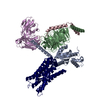

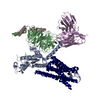
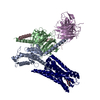

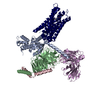
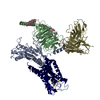
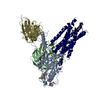
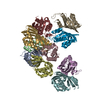
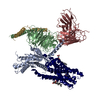
 PDBj
PDBj




































